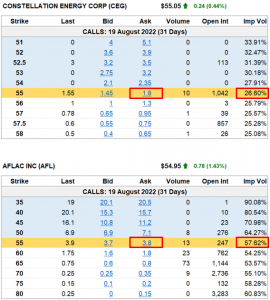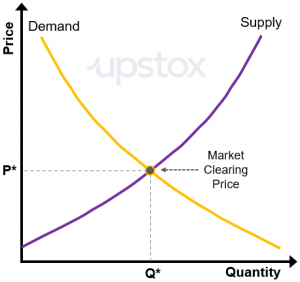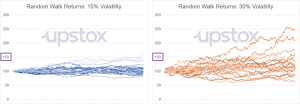Chapter 3
How Pricing Works?
In the US, the option markets are robust with thousands of individual stocks and ETFs being optionable. The concepts in the example are exactly the same for the India markets; we are only using US companies because the large number of optionable stocks in the US results in situations like our below example happening quite frequently (making it simpler to find a clear illustration).
Illustration 1 displays the call-side of the option chain for Constellation Energy Group and Aflac. Constellation Energy is a component of the S&P 500 and is a provider of electrical energy and natural gas. Aflac is also a component of the S&P 500 and is a supplier of supplemental health insurance. On the particular date of the snapshot below, both companies were trading close to $55 per share and both had call options with $55 strikes available for 19 August 2022.
Since Constellation Energy was trading at $55.05, the 55-strike had an intrinsic value of $0.05. This particular call option had an asking price of $1.80 so the time value was $1.75 ($1.80 - $0.05).
Aflac was trading at a slightly lower value of $54.95. This means that the 55-strike had no intrinsic value because the underlying stock was $0.05 below the strike price. However, the asking price for the Aflac call option was $3.80 which is more than double the price of the comparable call option of Constellation Energy!
Why the difference? Read on.
Illustration 1: Option Chain for two stocks

Understanding implied volatility
The answer is that the implied volatility of Aflac is more than double the implied volatility of Constellation Energy (57.62% vs. 26.60%). In an earlier chapter, we had discussed how ‘more time’ means ‘more value.’ This simply means that options with more time until expiration will have more time value than those with less time until expiration.
However, all time isn’t equal – the higher the implied volatility, the more valuable the time.
This is seen in our example above where both options have the same time until expiration but radically different time values. Let’s dive deeper to understand the mechanics behind this.
For any product or service, there will be a demand-and-supply relationship that impacts price. Around the world through the pandemic, supply chains were negatively impacted resulting in shortage of goods ranging from toilet paper to furniture to computers. Since demand for these goods didn’t reduce, this led to a spike in prices for these goods.
Even more recently in 2022, the continued impact of the pandemic in combination with the war in Ukraine led to a reduction in supply of gas. Since demand didn’t change, and in some cases went up due to the desire to travel again, the price of fuel skyrocketed. Had the reverse happened, where fewer people demanded the product but many were selling it, the price would have dropped.
On any given day in the market, this is what happens to stocks. If there is great interest in a security and few are willing to sell, those that are willing to sell are able to command a higher price. On slow, uneventful days, stocks move little and are considered to be at the ‘market clearing price.’
Illustration 2: Supply and Demand Relationship to Price

As we’ve discussed with options, there is a relationship between the option price and the underlying stock or index price: the intrinsic value. If a stock or index moves up in price, then the price of the option will go up. But this only describes the mechanical relationship between the underlying and the option. There are separate market dynamics of supply and demand that directly impact the option itself.
For example, 100 people may wish to purchase a stock, but only 50 are selling, thus driving the price of the stock upwards. While the option price will rise because of this stock price movement, it could rise further if there is an added supply-demand imbalance. Perhaps 100 people wish to purchase a particular expiration-strike call option, but only 10 wish to sell. This would drive the price of the option even higher than what the change in the stock price would justify.
How volatility impacts option price?
When we first introduced call and put options, we highlighted that these are contracts with specific, pre-defined terms including the underlying security, strike price, and expiration date.
There are two variable components that also can impact the option’s price: the underlying security’s price and the volatility of the underlying security. As we reviewed in the chapter on Time Value and Intrinsic Value, the more volatile a security, the more valuable it could potentially be. Here is another illustration in the two side-by-side charts below. These two charts plot what is known as a random walk, or a simulated stock price movement. In each chart, there are 25 iterations of random stock price movements over a one-year period.
The chart on the left simulates a stock that has a 15% annual volatility while the stock on the right has a 30% annual volatility.
- The range of outcomes for the simulated stock with 15% volatility is between 79 and 160 with a median value of 104.
- The range of outcomes for the simulated stock with 30% volatility is between 63 and 250 with a median value of 114.
If we were interested in outcomes greater than 150, the stock with a volatility of 30% would have a greater chance of achieving this. In these limited simulations, the virtual stock with lower volatility achieved a price of more than 150 in only 1 of 25 iterations. However, the virtual stock with the higher volatility exceeded this price point in 5 of the 25 iterations.
So, the supply-and-demand dynamics that play out through options trading can be implied through volatility. If more traders wish to buy an option than sell, this implicitly means that these traders looking to purchase believe that there is a favourable future outcome associated with this option. In order for that to happen, the volatility would need to be higher. This drives the price of the option upwards.
Illustration 3: Two hypothetical assets with different price volatility

To Conclude:
- Two variable components impact the price of an option - the underlying security’s price and the volatility of the underlying security.
- If more traders wish to buy an option than sell, the volatility would be higher. This drives the price of the option upwards.
- The more volatile a security, the more valuable it could potentially be.
- Options with more time until expiration will have more time value than those with less time to expiry.
- Also, the higher the implied volatility, the more valuable the time value (extrinsic value).
We recognise that this concept may be confusing at this point. In the next chapter, we will dive even further into volatility: both historical as well as implied volatility.

Test your OQ (Options Quotient)
Take your first step towards financial independence with the right training.



